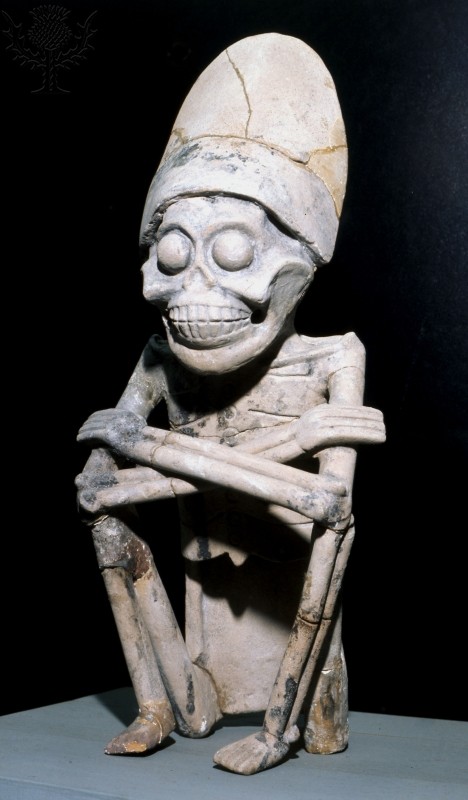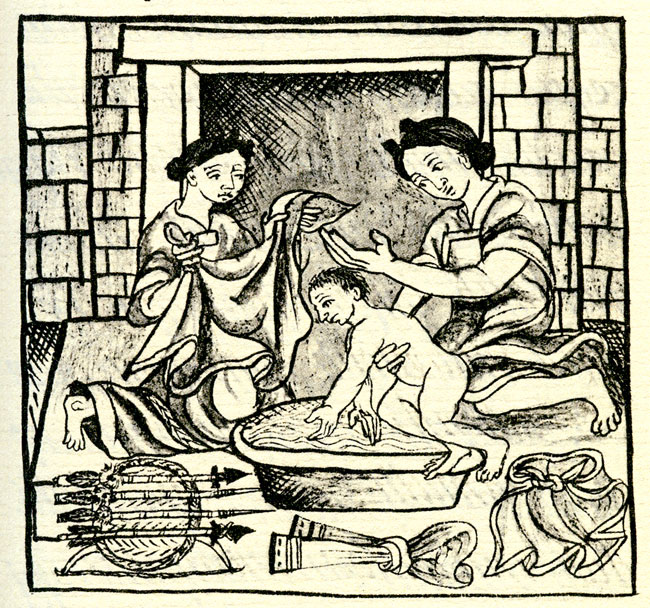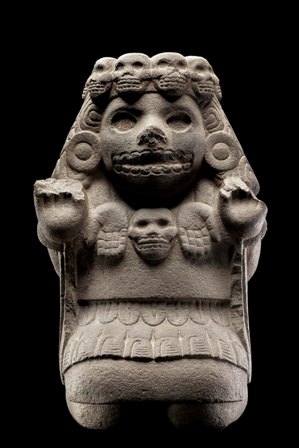Childbirth was an important event among the Aztec/Mexica. Pregnant women were supported and attended to by tlamatlquiticitl, (midwives), who provided advice, medical care, and facilitated rituals intended to prepare the mother-to-be to take on the role of a warrior.
For Mesoamerican people childbirth was considered a form of battle, therefore, women who gave birth were revered as heroes and great warriors. “When the pregnant one already became aware of labor pains, it was said her moment of death had come to pass…and when the baby had arrived on earth, then the midwife shouted; she gave war cries, which meant that the woman had fought a good battle, had become a brave warrior, had taken a captive, had captured a baby.” (Florentine Codex 6:167)
Losses on any battlefield are inevitable, so women who died as a result of childbirth were given the same honor as men who fought and died in conflict. Both of these roles were deemed great sacrifices for the good of the community.
After her death the woman’s body and hair, which was left loose, would be washed, and she would then be dressed in her best clothes. The midwife would recite a prayer acknowledging her sacrifice, and praising the woman for her bravery:
Oh strong and war-like woman, much loved daughter! Brave woman, beautiful and tender as a dove. My lady, you have struggled and worked bravely, you have won. You are made in the likeness of our mother the Lady Cihuacóatl or Quilatzli. You have fought valiantly; you have used the shield and the sword bravely and struggled, using that which our mother the Lady Cihuacóatl Quilaztli has put in your hand. (as recorded by Sahagún (1829/1999))
When possible, her husband would carry her body to a special site dedicated to goddesses. Along the way he would be accompanied by the attending midwife, and the elder women of the community would arm themselves with swords and shields and perform battle cries.
Once they reached their destination, for next four days the deceased woman’s family and friends would watch over and defend her corpse from other warriors. According to Manuel Aguilar-Moreno the women became “such powerful beings that when a woman died in childbirth, her family had to guard her body carefully to prevent thieves from taking relics: the middle finger of her left hand, or her hair. Warriors believed that if they placed this finger or hair in their shields, it would make them stronger and braver, and blind their enemies.”
Finally, on the fourth day, it was believed that the teyolia, (the spirit or vitality of the individual), separated from the corpse and then continued on to an afterlife. Unlike many other belief systems, Aztec/Mexica afterlife destinations were not dictated by a person’s deeds carried out during their lifetime, but by the specific events of their death. In result, the teyolia of a warrior would transform into a spirit being and reside in a place of honor called Tonatiuh-Ilhuicac, the Heaven of the Sun. Here, they acted as escort to the sun, accompanying its daytime movements across the sky. Once four years had passed, male warriors would be reborn as butterflies or hummingbirds who could travel freely between the realms of both the living and the dead.
As for the women who died in childbirth, they would become goddesses called Cihuateteo, portrayed with skeletal faces as seen here.
It was the Cihuateteo’s duty to accompany the sun as it set, carrying it on a blanket fashioned from the feathers of colorful quetzal birds, while singing to the sun before gently depositing it in the underworld, or land of the dead, for its nightly respite – not unlike the women would have done for their own infants had they survived.
Cihuateteo were also permitted to visit the crossroads of the earth every fifty-two days. In great contrast to the men who became butterflies and birds, the women took on the form and demeanor of fearsome warriors. Transforming into a terrifying hybrid of human and beast comprised of a human body bearing a skeletal face, and full, youthful breasts which signified the fact that they were never able to nurse their babies. Their feet and hands were often depicted with sharp talons, their waists encircled by a belt adorned with a skull resting at the small of of the back, her loose hair swirling around a crown of skulls.
 Aztecs/Mexicas constructed shines or temples at crossroads to honor the deceased mothers. As the fifty-two day mark approached, they would decorate the shrines with flowers and paper, and leave out gifts and offerings for the Cihuateteo, including food like tamales, breads or amaranth shaped into figures of butterflies, and corn.
Aztecs/Mexicas constructed shines or temples at crossroads to honor the deceased mothers. As the fifty-two day mark approached, they would decorate the shrines with flowers and paper, and leave out gifts and offerings for the Cihuateteo, including food like tamales, breads or amaranth shaped into figures of butterflies, and corn.
Today, some of the ancient statues of the Cihuateteo that appeared in shrines and temples, are on display at the anthropology museum in Mexico City and also in Xalapa, where they were found in a chamber with a larger-than-life size statue of a skeleton, as though they were companions or helpmates of death himself.
Spanish colonizers in Mesoamerica who were tasked with recording and relating information about “New Spain” to officials back home, did so with various biases and intentions. In several of their accounts they state that on the days when Cihuateteo visited the earth, that the people were deeply afraid of them and believed they would not only steal living children, but cause illness. This seems almost a contradiction to the veneration people held for these mothers upon their deaths. Demonization of Cihuateteo has continued with modern comparisons to “female vampires” who are out to seduce, trick, and entrap men, as well as kidnap children, but this misogynistic spin doesn’t have much evidence to support it.
According to scholar Anne Key, it is perhaps more likely that the colonizers, who were guilty of portraying “Mesoamericans as sub-human, therefore deserving of being enslaved, exploited, and abused by the conquistadors,” struggled with accepting female goddesses, and instead the Cihuateteo were “demonized, reduced, and characterized as malevolent specters,”* in their retellings.
May our own future retellings of these lost women restore and acknowledge the reverence and respect they were given in death, in lieu of reducing them to common tropes that only value the female body if it can serve society by carrying out maternal duties, be sexualized, or serve as a scapegoat. Our society places women’s bodies in a strange and unique liminal space between life bearer and death bearer. According to Dr. Tomi-Ann Roberts, “I find that it is hard to think about the fact that lactation, childbirth, and menstruation are all about giving life, and yet they are reminders of corporeality, our animal nature and mortality. So women, in being able to give life, have been considered across time and culture as bearers of death.”
These women died during the act of creating something that bore their hopes and dreams for themselves, the future, and their community. In their memory let us embrace and celebrate the archetype of the mother in all of us – as a brave warrior, creator, and bearer of both life and death.
Additional Resources
The bulk of this piece is based on the research and work of Anne Key.
*Key, Anne. “Death and the Divine: The Cihuateteo, Goddesses in the Mesoamerican Cosmovision.” PhD diss., California Institute of Integral Studies, 2005.
Sahagún, Fray Bernardino. Florentine Codex: General History of the Things of New Spain. 12 vols. Translated by Arthur J. O. Anderson and Charles E. Dibble. Santa Fe, NM: School of American Research and University of Utah Press, 1950–82.
Aguilar-Moreno, Manuel. Handbook to Life in the Aztec World. Oxford: Oxford University Press, 2007.
Cihuateotl, Metropolitan Museum of Art
Call the Aztec Midwife, National Geographic
The Aztec Women Who Became Goddesses After Dying During Childbirth, Cultura Colectiva
Giving Birth Was One Big Battle, Mexicolore


